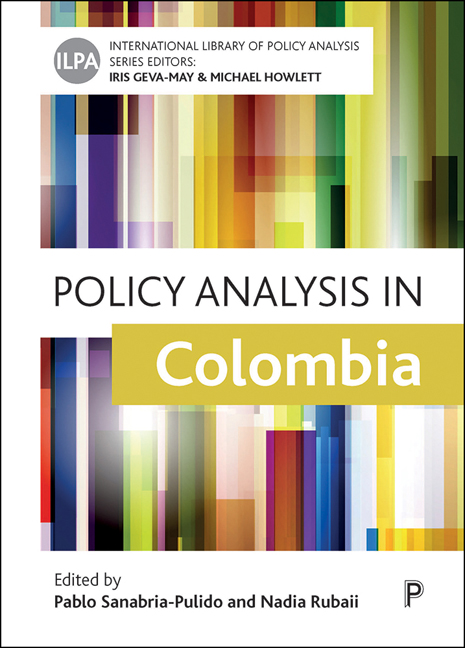Book contents
- Frontmatter
- Dedication
- Contents
- List of Figures and Tables
- List of Abbreviations
- Notes on Contributors
- Editors’ Introduction to the Series
- Policy Analysis in Colombia: An Introduction
- Part One Policy Analysis in Contemporary Colombia
- One The policy Analysis Movement in Colombia: The State of the Art
- Two Evolution of Policy Analysis as a Field of Study and Instruction in Colombia
- Three Policy Analysis, Bureaucratic Capacity and Public Administration Reforms in Colombia
- Part Two Policy Analysis within National and Subnational Governments
- Four Policy Analysis Inside Central Government in Colombia
- Five Policy Analysis and the Legislature in Colombia
- Six Policy Analysis in the Colombian Constitutional Court
- Seven Metropolitan Governance and Policy Analysis in Colombia
- Eight Policy Analysis for Decision Making in Colombian Local Governments
- Part Three Policy Analysis in Key Policy Domains
- Nine Policy Analysis in the Education Sector in Colombia
- Ten Policy Analysis in the Health Sector in Colombia
- Eleven Policy Analysis and Decision Making in the Military Forces: The Havana Experience
- Twelve Technocracy, Decision Making and Economic Policy in Colombia
- Thirteen Social Policy, Target Populations and Policy Analysis in Colombia
- Part Four Policy Analysis Beyond the State
- Fourteen Political Parties and Policy Analysis in Colombia
- Fifteen Policy Analysis and NGOs in Colombia
- Sixteen Media, Evidence and Policy Analysis in Colombia
- Conclusion: Building Capacity for Policy Analysis Amid Tensions and Challenges in Colombia
- Index
Nine - Policy Analysis in the Education Sector in Colombia
Published online by Cambridge University Press: 10 March 2021
- Frontmatter
- Dedication
- Contents
- List of Figures and Tables
- List of Abbreviations
- Notes on Contributors
- Editors’ Introduction to the Series
- Policy Analysis in Colombia: An Introduction
- Part One Policy Analysis in Contemporary Colombia
- One The policy Analysis Movement in Colombia: The State of the Art
- Two Evolution of Policy Analysis as a Field of Study and Instruction in Colombia
- Three Policy Analysis, Bureaucratic Capacity and Public Administration Reforms in Colombia
- Part Two Policy Analysis within National and Subnational Governments
- Four Policy Analysis Inside Central Government in Colombia
- Five Policy Analysis and the Legislature in Colombia
- Six Policy Analysis in the Colombian Constitutional Court
- Seven Metropolitan Governance and Policy Analysis in Colombia
- Eight Policy Analysis for Decision Making in Colombian Local Governments
- Part Three Policy Analysis in Key Policy Domains
- Nine Policy Analysis in the Education Sector in Colombia
- Ten Policy Analysis in the Health Sector in Colombia
- Eleven Policy Analysis and Decision Making in the Military Forces: The Havana Experience
- Twelve Technocracy, Decision Making and Economic Policy in Colombia
- Thirteen Social Policy, Target Populations and Policy Analysis in Colombia
- Part Four Policy Analysis Beyond the State
- Fourteen Political Parties and Policy Analysis in Colombia
- Fifteen Policy Analysis and NGOs in Colombia
- Sixteen Media, Evidence and Policy Analysis in Colombia
- Conclusion: Building Capacity for Policy Analysis Amid Tensions and Challenges in Colombia
- Index
Summary
Introduction
The Colombian Constitution of 1991 shaped the development of the social sector in Colombia, particularly in the provision of education and health. The new Constitution declared Colombia a “social rights state” and established education as a right and a public service with a social purpose. At the same time, it declared decentralization as a fundamental principle. These two features led to a series of reforms during the 1990s in terms of the institutional and organizational arrangements for the provision of education services. Within this context, a new set of reforms in education took place. One of the most important was the teachers’ reform, an area that continues to have repercussions even 25 years later.
This chapter looks at teacher policy to illustrate the practice of policy analysis in education policy in Colombia at the national level after the 1990s reforms. In particular, we use reform in policies regarding public school teachers as a case to analyse the process of policy formulation and implementation in the education sector in Colombia. We focus on teacher policy for two main reasons. First, it has marked the education sector over the past 20 years, defining several issues that have a direct impact on the quality of primary and secondary education (such as whether or not teachers are required to have professional degree, or whether or not teachers who do not perform well should stay in schools). Second, teacher policy involves several stakeholders and decisions in several domains, allowing illustrating the complexity of policy analysis in the education sector. The chapter has four main objectives: to explain how education policy is constructed; to document the main criteria used in education policy design; to identify the main stakeholders involved; and to assess the extent to which technical and political factors weigh in the policy construction process.
Teacher policy refers to policies governing the hiring, training (pre-service and in-service), compensation and evaluation of teachers in the public sector. Specifically, we focus on six key dimensions: pre-service teacher training; selection and hiring of teachers; retention and promotion; performance evaluation; inservice training; and salaries. These dimensions follow the literature on education policy (García et al, 2014).
- Type
- Chapter
- Information
- Policy Analysis in Colombia , pp. 153 - 168Publisher: Bristol University PressPrint publication year: 2020



